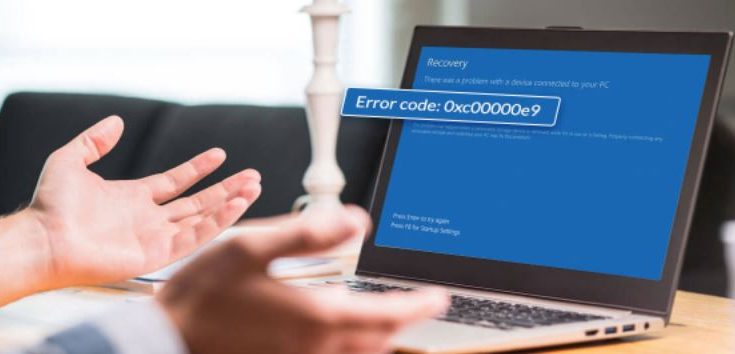Windows error code 0xc00000e9 is a standard Windows Boot Manager error that indicates a hardware failure or a corrupted system file encountered during boot. It appears shortly after the computer boots up but before the Windows login screen, as shown below:
There was an unexpected I/O error. 0xc00000e9 is the error code.
This article’s instructions apply to Windows 10, Windows 8, Windows 7, and Windows Vista.
causes of Error Code 0xc00000e9 in Windows
The 0xc00000e9 error code is always related to the Windows boot process. An I/O error, also known as an input/output error, occurs when the system cannot access a drive or disc, preventing it from reading or copying data. Because the Error Code 0xc00000e9 is so standard, there are numerous possibilities:
- External hardware or PC components that are not working correctly.
- Input or output ports that have been damaged.
- Components are incorrectly seated, such as a disconnected hard drive that does not make contact with the motherboard.
- UEFI, BIOS, or CMOS settings that have been incorrectly configured.
- Corrupted system files or issues with the Windows Registry
- There are issues with Windows Update.
- A boot sector virus or other malicious software.
How to Repair Error Code 0xc00000e9 in Windows 10, 8, 7, and Vista
Try the following steps in order until the Error Code 0xc00000e9 is resolved:
Restart your computer.
If you cannot log in to your computer, perform a hard reset by holding the power button until the computer shuts down, then restarting it. Many issues can be resolved by restarting a computer. However, if the Error Code 0xc00000e9 persists, investigate further to determine the underlying cause.
Remove all external devices.
Remove any external hard drives, flash drives, or other USB devices before restarting the computer. These extraneous devices can occasionally interfere with the boot process. Remove them one at a time to determine which device is faulty.
Check for errors in Windows.
For example, if Windows install successfully after a reboot, use the built-in Windows Error Checking tool and the SFC scan commands to check for problems on the hard drive and system files. The chkdsk command can launch the Windows Error Code 0xc00000e9 Checker tool from the command prompt.
Start in safe mode.
When Windows fails to boot normally, you can usually access the operating system through safe mode. If that works, you can use Windows to perform many of the troubleshooting steps listed below.
Drivers should be updated.
If you can boot into Windows, check to see if all device drivers, particularly those related to I/O ports and storage, are up to date.
Execute a Windows Startup Repair.
If you cannot log in to Windows, use a Windows disc or a prepared USB drive containing the Windows automatic repair tools. A Startup Repair can repair corrupt system files, registry Error Code 0xc00000e9 , and missing content, all of which can cause this error to appear.
Scan the computer for malware.
First, use a bootable antivirus tool if a virus prevents Windows from booting. Then, on another machine, download an antivirus program for Windows and save it to a bootable drive. Most virus removal tools include a bootable rescue tool for scanning a system from a command prompt.
Examine the hard drives.
The simplest method is to use a free hard drive testing tool. Then, run the device without removing the hard drive if you can access the command prompt. Another option is to change the hard drive with a known-good drive. You could also try placing the hard drive in another machine.
Alter the boot order.
The boot sequence may be different if you installed a new hard drive, plugged in an external drive, or connected a USB device. It may also occur if the system BIOS is updated. First, access the BIOS or UEFI settings on the computer, then ensure that the hard drive on which Windows is installed is listed at the top of the boot sequence.
Change the volume boot code to BOOTMGR. The volume boot code can become corrupted or associated with a boot loader other than the default BOOTMGR found in Windows. This problem should be resolved by updating the volume boot code. Volume boot code issues can also lead to other problems, such as Hall.dll Error Code 0xc00000e9 .
Fix the Master Boot Record (MBR).
The Master Boot Record, like the volume boot code, contains data required for Windows to load. Because the MBR instructs Windows on which drive and partition to use during boot, repairing the MBR may resolve the Error Code 0xc00000e9 .
Turn off Windows Secure Boot.
The Secure Boot feature can prevent a computer from interacting with external hardware or software. Disable it temporarily to see if that solves the problem.
Run a system restore.
If the problem began after you installed a new device or program, use Windows system restore to restore the operating system to a previous state. A system restore deletes all changes made to Windows since the specified rollback date, so make a backup of any files you want to keep.
Perform a clean Windows installation.
Reinstalling Windows overwrites all system changes. As a result, corrupted or missing system files are restored to proper working order.
Examine for component failures.
If possible, inspect the computer for any loose or disconnected components. Next, repeat the process for any external devices that contributed to the error. If you discover a hardware problem, you can repair it yourself or contact the manufacturer for assistance in improving the computer. Check to see if a warranty covers a computer or other piece of hardware before you open it up. Then, you might be able to get it serviced professionally for free.
FAQ
In Windows 10, how do I resolve a “system thread exception not handled” error?
Because this error indicates a faulty driver, you must locate and remove the driver to resolve Error Code 0xc00000e9. To enter safe mode, press Windows key + R and type eventvwr in the Run dialogue box. Select System from the Windows Logs menu. Locate the system thread exception not handled log. Choose it to locate the faulty driver.
How do I resolve the error “Windows cannot access the specified device, path, or file”?
This error indicates that you may not have access to the device, path, or filename. Right-click the file or folder to resolve the issue and choose Properties > Security. Next, select Edit under Group or user names and make sure you have administrative privileges.
How do I resolve an error while attempting to connect to the Windows Live Calendar service?
ALSO SEE:
If you receive an error when attempting to connect to the Windows Live Calendar service, it is possible that your account has been upgraded, and your contacts and calendar are no longer in sync. If you can still log in, disregard the error and proceed. Alternatively, sign out and access the calendar at calendar.live.com.



